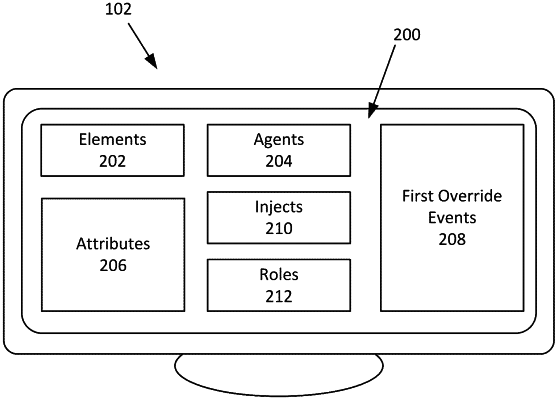| CPC G06Q 10/067 (2013.01) [G06F 3/04847 (2013.01)] | 21 Claims |

|
1. A method of organizing and conducting a computer-implemented simulation to support an exercise, the method comprising:
receiving, by at least one processor via a first graphical user interface (GUI) prior to the simulation, configuration data representing at least:
a) organizational nodes,
b) organizational pathways configured to interconnect the organizational nodes,
c) interorganizational relationships of the organizational nodes and the organizational pathways including product flow allocation associated with a flow of product through each of the organizational pathways,
d) one or more first events configured to change one or more of the interorganizational relationships at predetermined times during the simulation,
e) node capacities of the organizational nodes and pathway capacities of the organizational pathways, wherein each of the organizational pathways defines a first directional flow of the product between two of the organizational nodes, and
f) counterflow pathways each defining a second directional flow opposing one of the first directional flows, wherein the counterflow pathways facilitate one or more financial transactions associated with the first directional flow of the product;
generating, by the at least one processor, a framework of the simulation based on the configuration data;
storing, by a memory unit, the framework of the simulation until the simulation starts;
receiving, by the at least one processor via a second GUI during a first period of time in the simulation, at least one user input configured to dynamically change the product flow allocation of at least one of the organizational pathways in response to at least one of the first events;
determining, by the at least one processor, one or more second events based on the at least one user input, wherein the second events are configured to dynamically change the one or more of the interorganizational relationships differently from the first events;
changing, by the at least one processor, the node or pathway capacities as determined based on both of the first and second events;
changing, by the at least one processor, one or more of: the product flow allocation, at least one preliminary division, or at least one second capacity of the organizational pathways, as determined based on the counterflow pathways; and
automatically updating, by the at least one processor, one or more of the interorganizational relationships of the framework of the simulation in response to applying the second events in a second period of time following the first period of time.
|